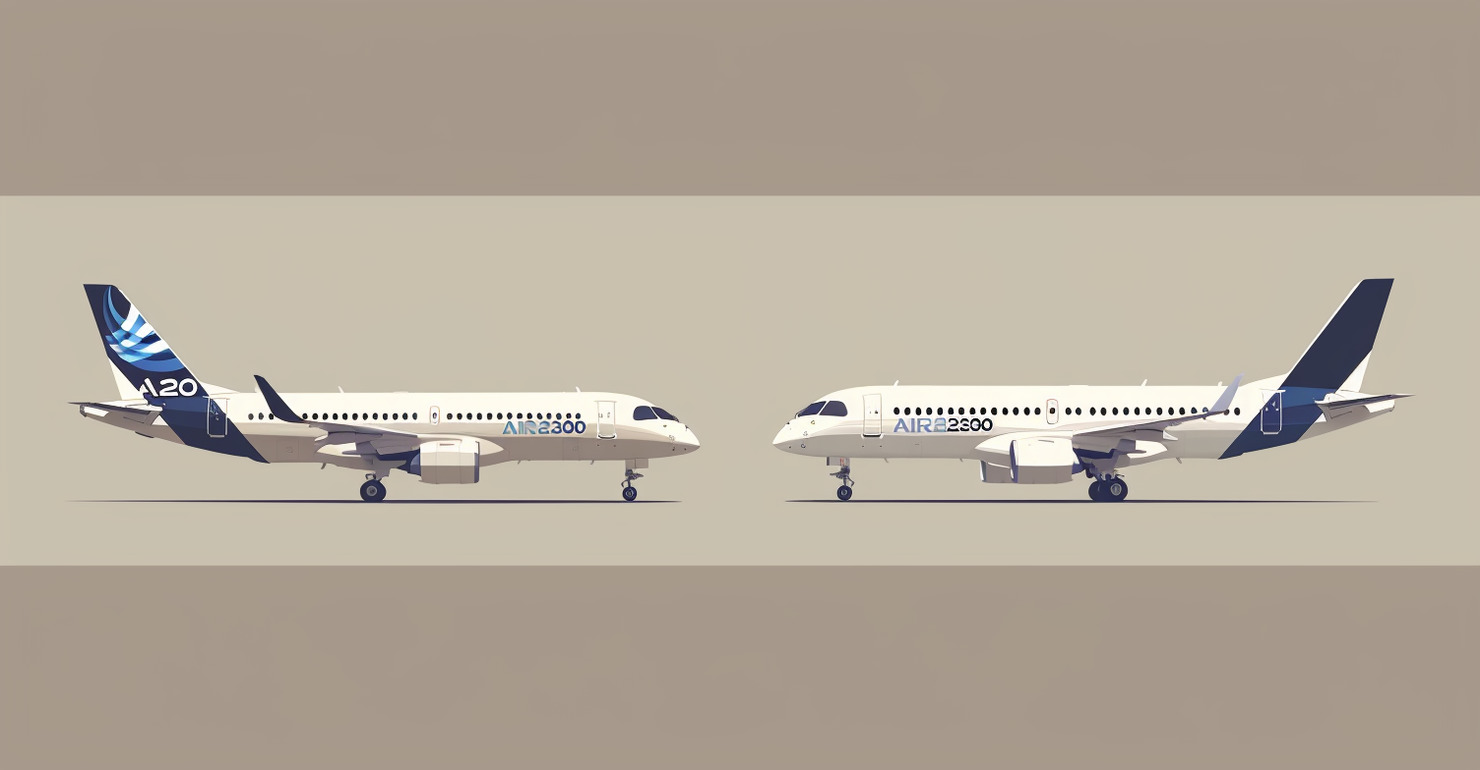
The Airbus A220: Small Aircraft, Big Impact
The Airbus A220, formerly known as the Bombardier CSeries, is a small aircraft with a big impact on the aviation industry. Since its launch in 2013, the A220 has gained recognition for its fuel efficiency, range, and operational flexibility. With its advanced aerodynamics and Pratt & Whitney engines, the A220 offers lower fuel burn per seat compared to other aircraft in its class. Its range and ability to land on shorter runways allow for point-to-point flights and access to underserved airports, expanding travel options for passengers. Airlines can deploy multiple A220 aircraft throughout the day, offering greater frequency on high-demand routes and catering to the needs of time-conscious business travelers. The A220 is a profitable and environmentally-conscious choice for airlines, making it a game-changer in the aviation industry.
About the Airbus A220
The Airbus A220, formerly known as the Bombardier CSeries, is a family of narrow-body airliners designed and produced by Airbus Canada Limited Partnership (ACLP). The A220-100, formerly known as the CS100, made its maiden flight in 2013, and the larger A220-300, formerly known as the CS300, followed soon after. With the acquisition of the program by Airbus in 2018, the A220 has gained popularity and proven to be a successful aircraft in its class.
The A220 stands out for its fuel efficiency and environmental performance. It offers significant fuel burn reductions compared to similar-sized aircraft, making it an economically attractive choice for airlines. Its advanced aerodynamics and Pratt & Whitney PurePower PW1500G engines contribute to lower fuel consumption per seat, reduced emissions, and decreased noise footprint. In fact, the A220 delivers 25% lower fuel burn per seat than previous generation aircraft.
The A220’s range and the ability to operate from shorter runways make it highly versatile. It can access underserved airports and open up new route opportunities, providing passengers with more direct flights to their destinations. The A220-100 can even operate at challenging airports like London City Airport, which has restrictions due to its short runway and high buildings.
Furthermore, the A220 offers operational flexibility for airlines. With its high frequency and multiple deployments, airlines can efficiently manage busy routes and cater to the needs of time-conscious business travelers. By deploying multiple A220 aircraft throughout the day, airlines can provide more frequent departures and better accommodate passenger demand.
The A220 has already gained recognition and attracted orders from airlines worldwide. It has become a profitable choice for airlines, allowing them to optimize their operations while meeting the growing demand for reliable and sustainable air travel. The A220 is a testament to Airbus’ commitment to innovation and meeting the changing needs of the aviation industry.
Fuel Efficiency and Environmental Impact
The Airbus A220 is a fuel-efficient aircraft that surpasses other models in its class, making it a profitable and environmentally-conscious choice for airlines. The A220’s advanced aerodynamics, combined with specifically-designed Pratt & Whitney PurePower PW1500G engines, contribute to an aircraft that delivers significant fuel burn reductions per seat compared to previous generation aircraft. It achieves 120 miles per gallon (MPG) fuel efficiency, outperforming its competitors.
In addition to its fuel efficiency, the A220 also has an impressive environmental scorecard. It emits lower CO2 emissions, reducing the carbon footprint of each flight. A fleet of 20 A220 aircraft can contribute to a reduction in CO2 emissions of about 1.1 million tonnes over 15 years. The A220’s reduced emissions make it a greener choice in an industry striving for sustainability.
Moreover, the A220 offers a range of up to 3,600 nautical miles, allowing for point-to-point flights and access to underserved airports. Its ability to operate from shorter runways opens up new route opportunities, reducing the need for passengers to transfer through hubs and optimizing the use of airports. This not only increases travel options for passengers but also helps reduce congestion at major airports.
By deploying multiple A220 aircraft throughout the day, airlines can provide greater frequency on high-demand routes, meeting the needs of time-conscious business travelers and maximizing revenue potential. The A220’s operational flexibility allows airlines to right-size their seat capacity for different routes, optimizing efficiency and profitability.
The A220’s fuel efficiency, environmental impact, and operational flexibility make it a game-changer in the aviation industry. The aircraft addresses the changing demands of airlines and passengers, offering a winning combination of economic benefits and environmental stewardship.
Fuel Efficiency and Range
The Airbus A220 stands out for its exceptional fuel efficiency and impressive range, making it a top choice for airlines looking to optimize costs and environmental impact. With its advanced aerodynamics and specifically-designed Pratt & Whitney PurePower PW1500G geared turbofan engines, the A220 delivers 25% lower fuel burn per seat compared to previous generation aircraft in its class. It achieves an impressive fuel efficiency of 120 miles per gallon (MPG), outperforming its competitors.
Additionally, the A220 offers a remarkable range, allowing for point-to-point flights and access to underserved airports. The A220-100 has a range of up to 3,400 nautical miles (6,300 kilometers), while the larger A220-300 can fly up to 3,350 nautical miles (6,204 kilometers). This extended range opens up new route possibilities and reduces the need for passengers to transfer through major hubs, providing more convenient travel options.
Furthermore, the A220 has the capability to operate from shorter runways and challenging airports. For example, the A220-100 is the largest aircraft that can operate at London City Airport, which has both a short runway and restrictions due to surrounding buildings. This allows airlines to offer direct flights from such airports, improving connectivity and accessibility for passengers.
The combination of fuel efficiency and impressive range makes the A220 an attractive choice for airlines seeking to optimize their operations, reduce costs, and minimize their environmental impact. The A220’s performance in these areas positions it as a game-changing aircraft in the aviation industry.
Reduced Emissions
The Airbus A220 is not only fuel-efficient but also contributes to reduced emissions, making it an environmentally-friendly choice for airlines. With its advanced aerodynamics and specifically-designed Pratt & Whitney PurePower PW1500G geared turbofan engines, the A220 delivers lower CO2 emissions compared to other aircraft in its class.
A fleet of 20 A220 aircraft can contribute to a reduction in CO2 emissions of about 1.1 million tonnes over 15 years. This substantial reduction in emissions highlights the A220’s commitment to environmental sustainability and reduces the carbon footprint of each flight.
In addition to lower CO2 emissions, the A220 also has a decreased noise footprint, making it a community-minded jetliner. The combination of advanced technology and innovative design enables the A220 to achieve a quieter flight experience for passengers and minimize noise disturbances for communities located near airports.
These environmental benefits are essential in an industry that is increasingly focused on reducing its impact on the environment. The A220’s reduced emissions make it a favorable choice for airlines looking to enhance their sustainability initiatives and meet regulatory requirements.
Overall, the A220’s ability to deliver reduced emissions, combined with its fuel efficiency and operational flexibility, makes it a powerful and eco-friendly aircraft in the aviation industry.
Operational Flexibility

The Airbus A220 offers exceptional operational flexibility, catering to the needs of airlines and passengers alike. With its range, performance, and ability to operate from challenging airports, the A220 provides airlines with versatile options for route planning and optimization.
One of the key advantages of the A220 is its range capability. The aircraft can fly up to 3,600 nautical miles (6,700 kilometers), allowing for long-haul flights and connections between distant destinations. This range opens up new route opportunities and enables airlines to offer more non-stop options, reducing travel time and enhancing passenger convenience.
Additionally, the A220 has the ability to operate from shorter runways and constrained airports. For example, the A220-100 is the largest aircraft capable of landing at London City Airport, which has a short runway and restrictions due to surrounding buildings. This enables airlines to serve city center airports and access destinations that would not be feasible with larger aircraft.
Moreover, the A220’s operational efficiency allows airlines to deploy multiple aircraft throughout the day. By utilizing several A220s instead of one larger aircraft, airlines can offer greater frequency on high-demand routes, accommodating the needs of time-conscious business travelers and providing more travel options for passengers. The A220’s flexibility in scheduling allows for optimized capacity management and can help increase overall profitability.
The A220’s operational flexibility gives airlines the agility to adapt to changing market demands, optimize route networks, and enhance passenger experience. It is a versatile aircraft that offers economic benefits and customer satisfaction, making it an ideal choice for airlines looking to maximize operational efficiency and flexibility.
Range and Access to Underserved Airports
The Airbus A220 offers excellent range capabilities and the ability to access underserved airports, providing airlines with greater route flexibility and expanding travel options for passengers.
The A220 has a impressive range, making it possible for airlines to operate point-to-point flights and serve destinations that were previously not feasible with larger aircraft. The A220-100 has a range of up to 3,400 nautical miles (6,300 kilometers), while the A220-300 can fly up to 3,350 nautical miles (6,204 kilometers). This extended range enables airlines to offer nonstop flights on longer routes, reducing travel time and enhancing the passenger experience.
In addition, the A220’s ability to land on shorter runways and operate from challenging airports is a significant advantage. For example, the A220-100 is the largest aircraft capable of landing at London City Airport, which has a short runway and restrictions due to surrounding buildings. This allows airlines to offer direct flights from city center airports, bypassing major hubs and improving connectivity.
By accessing underserved airports, the A220 opens up new route opportunities and provides increased convenience for passengers. It enables airlines to better serve secondary cities, allowing passengers to fly closer to their final destinations without the need for additional transfers. This improves regional connectivity and stimulates travel demand in various markets.
The A220’s range and ability to access underserved airports give airlines the flexibility to optimize their route networks and cater to the specific needs of different markets. It enhances the overall travel experience for passengers by offering direct connections and greater convenience. The A220 truly revolutionizes air travel by connecting more destinations and creating new possibilities for both airlines and travelers.
Multiple Deployments and High Frequency
The Airbus A220 offers airlines the advantage of multiple deployments and high frequency on their routes, providing greater convenience and flexibility for passengers. Instead of relying on a single large aircraft, airlines can deploy two or three A220 aircraft throughout the day to meet demand.
By offering multiple departures per day on high-demand routes, airlines can increase flight frequency and accommodate the needs of time-conscious business travelers. Passengers have the convenience of choosing from more departure options, allowing them to plan their travel according to their preferred schedule.
This approach also enables airlines to optimize capacity management. Rather than operating with a larger aircraft that may have excess seating capacity on certain flights, the A220 allows airlines to right-size their seat capacity for different time slots throughout the day. This improves operational efficiency and helps maximize revenue potential.
The A220’s operational flexibility and efficiency also extend to turnaround times. With shorter turnaround times compared to larger aircraft, the A220 enhances productivity for airlines. The reduced time spent on the ground enables airlines to maintain schedules and offer more frequent departures.
Additionally, deploying multiple A220 aircraft allows airlines to provide better service to underserved airports. The A220’s range and ability to operate on shorter runways make it possible for airlines to expand their routes, connecting smaller airports that were previously underserved. This opens up new travel options for passengers and helps stimulate travel demand in various markets.
Overall, the A220’s multiple deployment capability and high frequency operations benefit both airlines and passengers. It allows airlines to optimize their operations, improve profitability, and cater to the evolving demands of travelers seeking flexibility and convenience.
Future Potential and Market Demand
The Airbus A220 has a promising future and is witnessing increasing market demand due to its impressive performance and versatility. As airlines continue to adapt to evolving market dynamics, the A220 offers a solution that meets the needs of both airlines and passengers.
With its fuel efficiency and reduced emissions, the A220 aligns well with the growing focus on sustainability in the aviation industry. As passenger awareness of carbon footprints increases, the A220’s ability to deliver lower fuel burn and reduced CO2 emissions positions it as a desirable choice for environmentally-conscious travelers.
Moreover, the A220’s range and flexibility make it suitable for a wide range of routes and market segments. Its ability to fly longer distances and access smaller airports expands travel options and connects underserved destinations, opening up new possibilities for airlines to tap into untapped markets.
The A220’s fuel efficiency also makes it economically attractive for airlines as they strive to optimize their operations and reduce costs. By deploying multiple A220 aircraft throughout the day, airlines can meet high demand on popular routes, offer greater flight frequency, and adjust seat capacity more efficiently, ultimately boosting revenue potential.
As the aviation industry continues to recover from the impact of the COVID-19 pandemic, the A220’s versatility positions it as an ideal aircraft for airlines to rebuild their networks and adapt to changing passenger demands. Its ability to offer both convenience and efficiency makes it a sought-after option for airlines looking to enhance their competitiveness in the post-pandemic landscape.
Overall, the Airbus A220 demonstrates strong future potential and market demand. Its fuel efficiency, range, and operational flexibility make it a valuable asset for airlines seeking sustainable and profitable growth in the evolving aviation industry.
Changing Aviation Landscape
The aviation industry is undergoing significant changes, and the Airbus A220 is well-positioned to meet the evolving needs of airlines and passengers. The traditional hub-and-spoke model is giving way to increased competition and a focus on differentiation in service levels. Airlines are now operating smaller, more frequent flights to offer flexibility and convenience to passengers.
Efficiency has become a key consideration for airlines as they seek to optimize profits amidst rising fuel prices and fare wars. The A220 addresses these needs with its highly fuel-efficient design. It offers impressive fuel burn reduction compared to other aircraft in its class, achieving 120 miles per gallon (MPG). This not only caters to airlines’ cost-saving strategies but also aligns with passengers’ growing demand for environmentally-conscious travel options.
Passengers are increasingly seeking both convenience and value for money. They want a range of departure times at major airports and the ability to fly direct from smaller airports rather than having to transfer through hubs. The A220’s extended range and its ability to operate from shorter runways allow airlines to connect underserved destinations and offer more point-to-point flights, meeting the demands of modern travelers.
As sustainable travel gains prominence, the A220’s fuel efficiency and reduced carbon emissions make it an ideal choice for airlines looking to reduce their environmental impact. The aircraft’s efficient performance and use of biofuels contribute to a greener and more responsible aviation industry.
Furthermore, as fuel prices continue to rise, the A220’s high fuel efficiency positions it as a profitable and cost-effective solution for airlines. Its versatility allows airlines to deploy multiple A220 aircraft throughout the day on high-demand routes, maximizing revenue potential and providing greater frequency for passengers.
The A220 is designed to adapt to the changing aviation landscape, offering efficient operations, flexibility, and customer satisfaction. With the increasing market demand for fuel-efficient and environmentally-conscious aircraft, the A220 is poised to play a significant role in shaping the future of air travel.
Meeting Future Needs
The Airbus A220 is designed to meet the future needs of the aviation industry, addressing key trends and challenges faced by airlines and passengers.
As the aviation landscape evolves, airlines are seeking more fuel-efficient aircraft to optimize profitability and reduce their environmental impact. The A220 excels in this regard with its high fuel efficiency, surpassing other models in its class. It achieves an impressive 120 miles per gallon (MPG), outperforming competing aircraft like the 737 MAX 8 and the A321neo.
In addition to fuel efficiency, the A220 has a range that allows for long-haul flights and direct connections between secondary cities. Its extended range of up to 3,350 nautical miles (6,200 kilometers) for the A220-300 and 3,400 nautical miles (6,300 kilometers) for the A220-100 enables airlines to serve diverse routes and expand their network reach.
The A220 also offers the capability to land on shorter runways and access challenging airports, such as London City Airport. This opens up new route opportunities and allows for connectivity to underserved destinations that may not be accessible with larger aircraft.
In response to changing passenger preferences, the A220 allows for increased flight frequency through its ability to deploy multiple aircraft throughout the day. This provides passengers with more departure options and improves flexibility for travelers. Airlines can accommodate higher demand on popular routes, enhance their operational efficiency, and maximize revenue potential.
Furthermore, the A220 is well-suited to meet increasing passenger demands for convenience, value for money, and environmental consciousness. Its fuel efficiency, range, and operational flexibility make it an attractive choice for airlines and passengers seeking a sustainable and comfortable travel experience.
As air travel continues to evolve, the A220’s design and capabilities position it as an aircraft that can deliver on future needs, providing airlines with economic benefits and passengers with enhanced travel options.
Conclusion
The Airbus A220 is a game-changing aircraft that offers a combination of fuel efficiency, impressive range, and operational flexibility. With its ability to deliver lower fuel burn, reduced emissions, and access to underserved airports, the A220 is a profitable and environmentally-conscious choice for airlines. Its versatile nature allows for multiple deployments and high frequency on popular routes, meeting the needs of time-conscious passengers. As the aviation landscape continues to evolve, the A220 is well-positioned to meet future demands, offering superior performance, comfort, and efficiency. It is set to play a significant role in shaping the future of the aviation industry.
A Profitable and Environmentally-Conscious Choice
The Airbus A220 is not only a profitable choice for airlines but also an environmentally-conscious one. With its fuel efficiency and reduced emissions, the A220 offers financial benefits while addressing sustainability concerns.
The A220’s fuel efficiency is impressive, surpassing other aircraft in its class. It achieves a fuel efficiency of 120 miles per gallon (MPG), outperforming competing models. This fuel efficiency leads to cost savings for airlines, as they can achieve lower fuel consumption per seat compared to previous generation aircraft.
In terms of emissions, the A220 offers a reduction in CO2 emissions compared to other aircraft. It contributes to a reduction in CO2 emissions of about 1.1 million tonnes over 15 years when a fleet of 20 A220 aircraft is deployed. This reduction is significant and aligns with the aviation industry’s commitment to reducing its environmental impact.
By choosing the A220, airlines can demonstrate their commitment to sustainability and meet the increasing demand for greener travel options. Passengers are becoming more conscious of their carbon footprint and seek airlines that prioritize environmental stewardship. The A220’s reduced emissions make it an attractive choice for eco-conscious travelers.
Furthermore, the A220’s operational flexibility allows airlines to optimize their operations and increase profitability. Deploying multiple A220 aircraft throughout the day on high-demand routes enables airlines to offer greater frequency, catering to the needs of time-conscious business travelers. This results in increased revenue potential for airlines.
In conclusion, the Airbus A220 is not only a profitable choice for airlines but also an environmentally-conscious one. Its fuel efficiency, reduced emissions, and operational flexibility make it an ideal aircraft for airlines seeking financial success while prioritizing sustainability.



